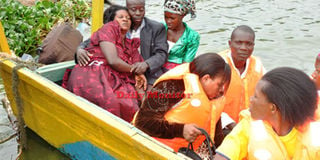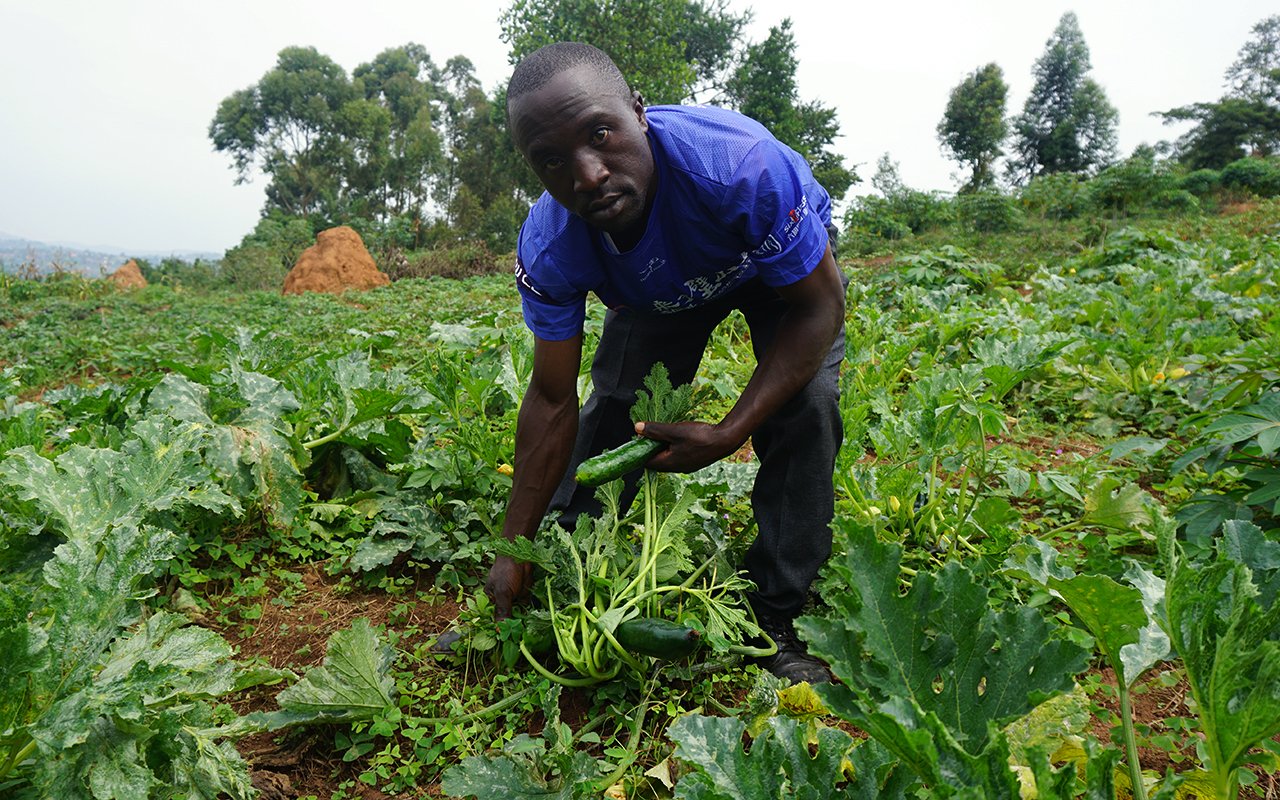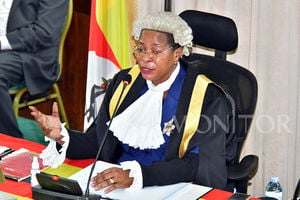Long road to good health services in Kalangala

In much of Kalangala District, the only way to access basic healthcare is via a boat crossing to another island or the mainland. Photo by Henry Lubulwa
What you need to know:
Health facilities are few and far between for the residents of the island district of Kalangala. This complicates healthcare in an area already burdened by the scourge of HIV, writes Henry Lubulwa.
Ronah Nankinga is a 36-year-old mother who lives on Butulume Island, Mazinga Sub-county. She has two boys and one girl, all below the age of eight. She is a fishmonger who ferries fish to the Kasenyi Landing Site in Entebbe in Wakiso District.
She has spent six years living in a grass-thatched wooden house on the island. All her children are of school going age. However, there is no nearby school to take the children to. During the day, she works as a fishmonger and in the nighttime, she sells waragi for survival.
“I have to work at both (jobs) in order to earn a living and cater for my family,” explains Nankinga, a single mother. She separated with her husband when he got a second wife after having their third child.
“I now have to work for my children. You know the young ones usually fall sick and it remains my task to take them to hospital,” she says.
To get to a nearby health centre, Nankinga has to board a boat and cross to a nearby island where she can find a health centre. The nearest health centre in the area is in Lujjaabwa, an island situated close to Rakai District.
It is 21 nautical miles away; about 36 kilometres by road. There is hardly any sign of land as she makes her way to hospital. Being the farthest sub county (Mazinga) in the district, it is made up of 13 islands, spread out far apart.
The waves on the lake are usually strong. The only means of transport is a wooden boat. Nankinga says she uses about 40 litres of fuel to access a health centre where she gets a dose of drugs for any sick person in her family.
“40 litres costs about Shs168, 000 here and that is what I use to get a free dose of drugs if I need any from a nearby health centre since we do not have a nearby clinic,” she says.
Nankinga usually travels with her three children to Kalangala’s main island in Bugala to get free medical care at health camps.
“I need to have all the children checked for all diseases so as to have them safe. It (the camp) is a free event and free medicine is given out to all people,” she says.
Too few and too far
Kalangala District has a total of 21 health centres. However, some of them (Health Centre IIs) were closed under the new policy undertaken by the Ministry of Health. According to the Kalangala District health officer Hillary Bitakaramire, the only operational health centres are those above the level of a health centre II.
“This leaves us with only 15 health centres operating on the scattered 84 Islands that make up the whole district,” Dr Bitakaramire says.
A resident of Nkose in Mazinga Sub-county nearest to the northern border with Tanzania’s Bukoba islands has to travel a minimum of 11 nautical miles on the lake to reach the nearest Kachungwa Health Centre III which only handles maternity health services, HIV treatment and minor illnesses.
“If one has a major illness or any complication, it is better to travel to Rakai and Masaka since it appears nearer than Bukasa and Kalangala Health Centre IVs. Sometimes, we reach our main health centres, only to be referred to Masaka.
So, it appears better to cross there,” says Resty Nakawungu, the area councillor who also doubles as the chairperson Kalangala Social Services committee.
For one to move from one island to the nearest health centre, he or she needs to hire a boat, coxswain, engine and fuel to reach the nearest health facility. For instance, to travel from Kitobo an outlying island, to Bufumira Health Centre III, one needs to buy 20 litres of fuel at a cost of Shs80,000, hire a coxswain at shs40,000 and a boat and engine at shs50,000.
“You use close to shs200,000 as transport to go to a health centre and pick tablets that can be sold at Shs3000 in a private clinic. We usually tell policy makers that island areas should be treated in a special way if people living there are to get basic services,” says Willy Lugoloobi the district chairperson.
“Our prayer is that we are catered for so as to improve our health services. Although we have 85 per cent staffing in all health centres in the district (128 medical officers), the facilities are still too few to cater for everyone,” he says.
No island hospital
Kalangala has no major hospital. The district relies on the services of Kalangala and Bukasa Health Centre IVs located in Kalangala Town Council and Bukasa islands respectively. The two health centres handle mainly HIV patients, maternity, and minor illnesses such as malaria and cough.
The district has for the last two years been asking government to elevate Kalangala Health Center IV into a referral hospital. However, the Minister of State in charge of Primary Healthcare asked the district to first institute a few more services in the main district health centre if it is to attain a hospital status.
Speaking during an HIV/ Aids stakeholders meeting held at the district headquarters in Kalangala last October, Ms Opendi said, “Government is clearly monitoring the services of Kalangala Health Centre IV. We expect that if we get better and more comprehensive services, Kalagala will attain hospital status.”
The district has a population of 53,000 people according to the statistics from the 2014 Population census. It also has the highest levels of HIV.
According to Kalangala District Forum for People Living with HIV Aids Network (KAFOPHAN), Kalangala has a total of 10,350 people who are living with HIV. “This is the number of those who have gone for an HIV test. We still have many other people who fear to turn up for the test,” says Henry Kizito, the Coordinator KAFOPHAN.
This, among many other challenges, remains Kalangala’s biggest health sector problem. The level of STI infection in the district, according to the district health officer, is at its highest especially at Kalangala’s landing sites in recent years.
According to Dr Bitakaramire, most of the people within the district suffer from Sexually Transmitted Diseases such as gonorrhea, syphilis, and HIV/ Aids, among others.
Also, people within the vicinity suffer from diseases such as malaria and others resulting from poor hygiene such as diarrhoea, bilharzia and dysentery, neglected tropical diseases and those related to tsetse flies.
“The government policy is that we should always have a health centre within walking distance. However, many of the people have to cross to the nearest centre by boat or else, one dies,” Dr Bitakaramire says.
According to the district personnel officer, Kalangala has a total of 128 health workers in the 15 accessible and operational health centres.
However, some of the medical doctors who were trained by the district with an aim of increasing the number of health workers absconded from duty due to the deplorable conditions in the health centres on several islands in the district.
Challenge of service delivery in Kalangala
Kalangala is an island district located in the middle of Lake Victoria. Sometimes referred to as the Ssese Islands, the district does not have territory on mainland. The district is located 67 kilometres, about 37 nautical miles on water, southwest of Entebbe in Wakiso District.
About six years ago, 37 of the 84 Islands in Kalangala District were uninhabited. The only inhabited islands were in close proximity and one only needed a canoe to cross from one island to the next. Although there were few health centres, it was easier to cross from an island annex.
No growth in health services
According to reports from Kalangala District NGO forum and Kalangala District medical office, the number of health facilities has not increased since. Many people who live in the numerous outlying islands have been dying without transport to a health facility.
“Since many people are poor, no one can look for money for a boat, fuel and engine hire so as to reach the health facility. In the end, many people suffer with untreated peculiar diseases which lead to death in some cases and such deaths are not registered for reference,” says Damalie Nabirimu, an officer with Advocacy for Better Health officer under the Kalangala District NGO forum.
This has affected health services in the area. For example, there are health centres whose health workers have left due to poor working conditions.
Communities are suffering without medical care hence the right of access to health services is denied. There are many people dying without getting access to health services, according to information from Kalangala District health department.
Residents of distant islands with no health facilities such as Miyana, Butulume and Nkose in Mazinga Sub County rely on community treatment outreaches that are usually organised by well-wishers within the Kalangala communities.
According to the Kalangala District health officer, Dr Hillary Bitakaramire, such outreaches treat a handful of diseases and are only conducted once a year.
Kalangala District health inspector Edward Bugimbi indicated that whereas the Health ministry requires all health centres to be located a distance of not more than five kilometres from one to the next; it is hard to tell the distance between health facilities across the lake in Kalangala.
Currently, the district has a total of 84 islands of which 63 are inhabited. However, there are only 15 effective health facilities, seven of which are located on the main island of Bugala. The rest of the centres are distributed among the 62 other inhabited islands which makes them inaccessible to many.




